If eyes are contaminated with hydraulic fluid use copious supplies of clean cold water to flood the affected eye's, seek medical advise.
Hydraulic (Brake, Clutch ) fluid coming into contact with your car will severally damage the paintwork, should such contact be made, immediately wash off with cold soapy water .
The gear box on the A160 covered by this site is a 5 speed/gear manual box with reverse, as distinct from an automatic, or semi automatic,(tiptronic) also fitted to the ' A' Class.
The clutch is hydraulically operated, the fluid being provided by the single master cylinder that also provides fluid to the braking system, ESP/ABS.
Fitted onto the master cylinder Back right hand corner of the reservoir is a corrugated tube, a this carries hydraulic fluid to the clutch slave cylinder sited to the rear of the clutch pedal, the fluid level in the reservoir must not be allowed to drop below the pipe.
The flexible tube a connects to the rear of the clutch slave cylinder and appears to be a push fit hose, certainly there are no clips of any sort on mine. The solid metal b tube coming away from the rear of the cylinder is clipped, this tube would be under pressure as the clutch was depressed, whereas the flexible would not, it merely keeps the slave cylinder topped up with hydraulic fluid.
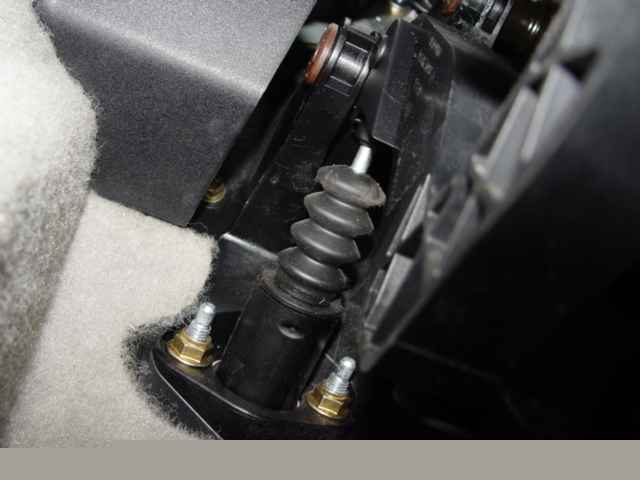 Photo shows the plunger of the slave cylinder in the cab.
Photo shows the plunger of the slave cylinder in the cab.Hydraulically operated clutch
Basically all this means is that instead of having a mechanical clutch where the clutch plate is released from the flywheel and thrust plate by
direct mechanical means usually incorporating cables and levers, in this case the clutch is released by the displacement of hydraulic fluid acting on a hydraulic cylinder which activates the thrust bearing which in turn releases the pressure on the clutch plate, as the clutch 1 is depressed.
Therefore it is imperative that the master
cylinder reservoir level be maintained at all times.
To the rear of the Clutch pedal below, can be seen the spindle going to the hydraulic system This has a built in play or movement of approx 12-15mm.
Riding the clutch
Whether a mechanical or hydraulic clutch were fitted in both instances 'riding the clutch' will cause unnecessary wear on the clutch components, The term 'riding the clutch' is best explained where the driver keeps his/her foot on the clutch pedal all the time, even slight pressure will effectively delete the play, or movement designed into the clutch system, this play normally ensures that the full pressure of the thrust plate C is applied to the clutch plate B and flywheel A while the car is in motion, Where this play/movement is deleted by 'riding the clutch' or bad adjustment the thrust bearing will be applying slight pressure on the thrust plate,
Holding the car static on an uphill incline while waiting at traffic lights etc is equally bad practice and results in substantial wear to the components parts of the clutch. The correct action should be to always apply the hand brake and by taking the car out of gear.
Badly worn clutch components will normally warn the driver well in advance of their complete failure. Where a clutch plate is very badly worn you will hear a dreadful screeching sound coming from the car as the unaware driver literally screeches off into the distance, but not for much longer as the flywheel will finally fail to drive the clutch plate and thus gearbox at all. Thrust bearing can normally be heard to whine, or even whistle, worn out clutch plates will allow the engine to rev without the appropriate movement of the car.
A badly worn clutch which is not replaced can damage the flywheel of the engine, this is due to the metal rivets which retain the clutch plate surfaces in position, even though the rivets are made of a softer metal than the flywheel they can after time still make grooves in the working face, with the result that the flywheel has to either be skimmed (placed on a lathe and a small amount of metal removed until a smooth flat surface is re-obtained to the flywheel face) or replaced with a New flywheel which in turn increases dramatically the cost of repair.
Bleeding the clutch of air is carried out in much the same way as bleeding the brakes.
If using the 'Ezi-bleed' system the bleed valve located on the underside of the gearbox is opened and fluid allowed to flow until it is completely clear of air bubbles, the valve/bleed nipple is then closed.
If undertaking this task manually then a second person will be required to operate the clutch pedal.
As with bleeding the brakes remove the dust cover E and push a suitable tube onto the neck of the bleed nipple F this should terminate in a suitable container or jar in which sufficient clean fluid has been placed to just cover the end of the tube. This will prevent air entering the tube, the clutch pedal is then fully depressed, several times or until clean, bubble free fluid leaves the tube, being collected in the jar or container.
Take great care when undoing the valve /bleed nipple, There is no need to remove it 1.5- 2 turns should be adequate to release the fluid. If the nipple /bleed valve is found to be very tight it may be necessary to apply a spanner to H In this instance, spray F with WD40 before making further attempts to slacken the valve.
Note that the flexible tube G going to the clutch cylinder should not be clamped as suggested with the brake hoses. It should be capped off using a suitable adaptor. This is due to the construction of the hose which will be severally damaged if clamped.
Also note that the joint from solid tube to flexible pipe lays between the underside of the floor and the top side of the engine. It would be very difficult to get at for replacement purposes without lowering the engine.
However Ian of Cornwall has this advise if you need to replace this tube:-
Hi Lofty,
With reference to your section about the clutch no. 58 in the list the hose running from from the front of the bulkhead below the servo to the slave cylinder does not require the engine to be moved.
I replaced my hose today, the flexi rubber portion at the slave cylinder end has perished badly. I needed to do it quickly as loss of fluid in the clutch line might also mean the loss of brakes as well as the clutch operation.
Remove the MAF sensor block and air box to give access behind the top of the rocker box and intake manifold. Unclipping the hose from both ends is relatively easy. Provide lots of rags under the servo and a receptacle under the clutch housing to catch hydraulic fluid.
Pulling the old pipe section out from the retaining clips and just below the front of the bulkhead then working the new one back in is the fiddly part and I found I had to unbolt the lower steering column bolt to be able to move it about a little made routing the new pipe in marginally easier. I'm lucky, I have small hands. Someone with bigger hands will struggle !
Just be careful not to fully pull out the retaining clips from the hose connections as they would be a pain to relocate to.
Once in. refilling and bleeding the clutch line is simple with a pressure bleed kit.
No engine lowering required.
Hope this is useful to all those disciples out there.
Ian,
Many thanks Ian, it helps to keep running costs down and cut out the High prices charged by Mercedes Workshops.
When bleeding the clutch or braking system ,remember to keep the master cylinder, or easy bleed container topped up to at least the min level. And top the master cylinder reservoir up to the maximum mark on completion.
When ever replacing the clutch assembly it is advisable to replace the hydraulic thrust bearing as it is this component that is employed for disengaging and engaging the clutch plate from the flywheel/thrust plate every time a gear is changed on a manual gearbox.
The unit is actuated by the displacement of hydraulic fluid as the clutch pedal is depressed, as indicated above the fluid is supplied from the single reservoir which supplies fluid to both the brake and clutch systems.
A Indicates the portion of the thrust bearing that revolves as it comes into contact with the thrust plate, it is for this reason that you should not drive or stand for long periods with the clutch depressed, or foot resting on the clutch pedal while driving.
This unit may be serviceable, but what ever you decide remember if a fault occurs on the unit after the engine is replaced there is no way of getting at it without removing the whole unit, engine and gear box again so the cost of a new unit when you replace the clutch has got to be worth while.
Remember also that it is not just the bearing that will need replacing , the seals in the hydraulic slave cylinder will also have been in the car for many years replacing the complete unit with new has therefore got to make financial sense unless you replace the bearing and seals in the slave cylinder.
Where these components are replaced, they should be inspected for signs of oil contamination on the used clutch plate, this will normally take the form of a dark polished smooth surface rather than the dry worn surface one would normally expect to see. I have seen clutch plates removed in as good as new condition but oil contaminated which renders them useless where this is the case inspection of both the crankshaft oil seal and gear box lay shaft oil seals should follow. Failure to replace a leaking seal will result in the life of the new clutch parts being dramatically shortened.
The diagram (right) shows the three major components of the manual clutch assembly Including the hydraulically operated thrust bearing.
This photo shows a newly installed thrust plate and clutch plate, when fitting the thrust plate it is vital to get the clutch plate centralised on the flywheel, If it is not fully centralised then difficulty will be experienced when re fitting the gearbox to the engine. In garages a dummy lay shaft would normally be used to ensure that the clutch plate is accurately located as the thrust plate is bolted into position.
1. shows the the nose of the starter motor , the point at which the starter (dog) gear meets the flywheel.
Note the starter located on the top of the engine.
2Tyhe central spline of the clutch plate assembly can be seen through the thrust plate. It is this which must be central the the thrust plate.
3 Thrust plate assembly.
4 Note the hoses etc on the top of the engine which must be carefully positioned as the engine is being re-installed.
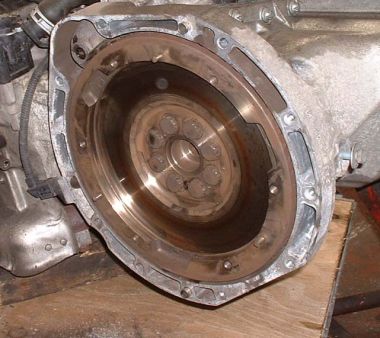
The photo shows the flywheel in more detail, in this instance I suspect the engine has been standing for a while as the face of the flywheel is not shiny as one would expect, it is important to ensure that the flywheel surface is flat and smooth, where badly worn clutch plates are allowed to slip on the flywheel before being replaced grooves can be worn in the flywheel face make it necessary to have it skimmed or in severe cases replaced. it is therefore wise to replace the clutch as soon as possible if slipping occurs.
This can be caused by a badly worn clutch plate or in some cases gearbox lay shaft or main crank shaft oil seal leaking in both case the oil contaminates the absorbent surface of the clutch plate causing it to slip on the flywheel and thrust plate drive surfaces. Note the large bolts that connect the flywheel direct to the end of the crankshaft.
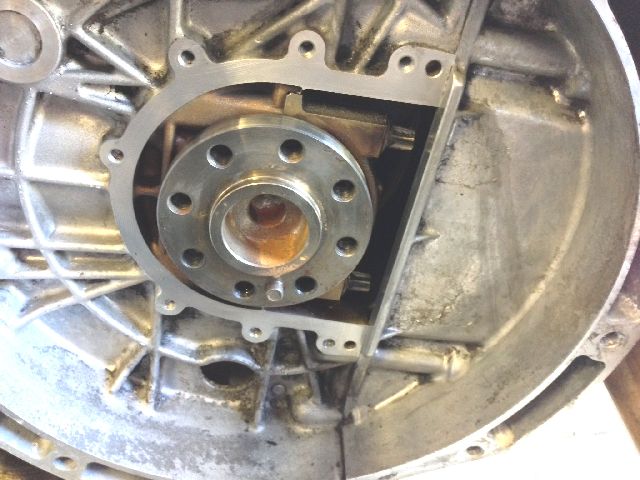 Where it is necessary to remove the flywheel due to a leaking crankshaft oil seal, or to replace a damaged flywheel/ring-gear the Engine oil should be drained.
The is because the flywheel securing bolts penetrate the engine crankshaft casing which will allow oil to escape from the lower bolt holes while undertaking the necessary work/repair .
Where it is necessary to remove the flywheel due to a leaking crankshaft oil seal, or to replace a damaged flywheel/ring-gear the Engine oil should be drained.
The is because the flywheel securing bolts penetrate the engine crankshaft casing which will allow oil to escape from the lower bolt holes while undertaking the necessary work/repair .In the photo below it was thought the crankshaft oil seal was worn when in fact the engine oil, which had not been drained was escaping through the lower bolt holes.
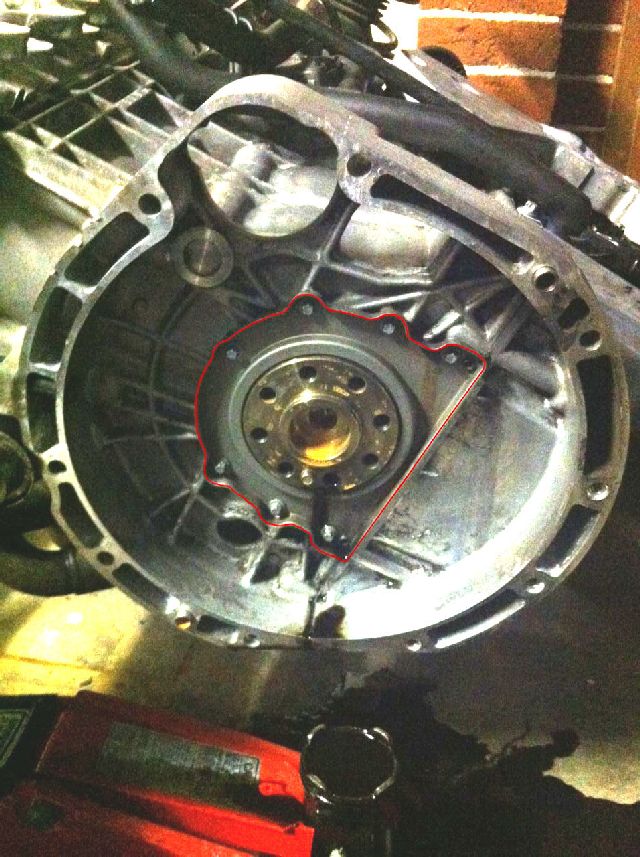
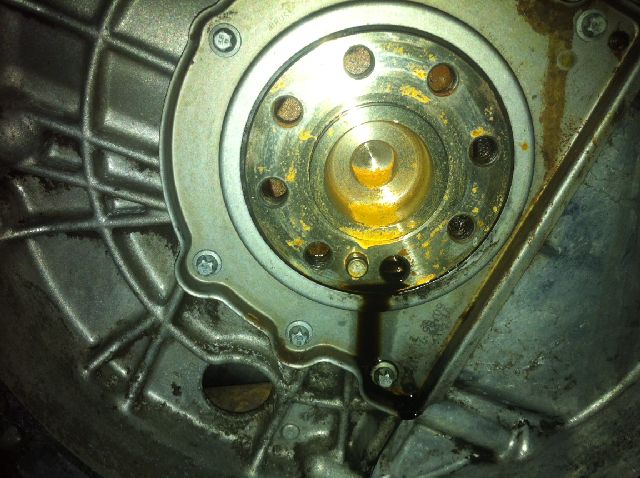
If following removal of the clutch plate it appears to be oil contaminated then check for the cause :- Check the gear box lay shaft oil seal. and the crank shaft oil seal.
To check the back crankshaft oil seal you will need to remove the flywheel and expose the seal by removing the cover plate outlined in red, in both cases it will be well worth while as even a new clutch-plate will quickly become contaminated if an oil seal has developed a leak, making it necessary to remove and strip the clutch assembly again as well as replacing the clutch plate.
Suspect clutch
An 'A' Class that has been driven sensibly and used for normal domestic/pleasure uses distinct from from business or towing relatively heavy trailers (max towing limit ) should reach 100,000 miles plus before the clutch needs overhauling, i.e. new clutch plate thrust plate and thrust bearing.
If you think you have a suspect clutch, run the car onto a level surface, apply the hand brake, and having put the car in 4th or 5th gear ease the clutch, if the clutch is in good condition the car will stale as the clutch is fully released. (engine will stop) This procedure should not be undertaken unless there is good cause to believe the clutch is suspect. If the clutch passes that test then there is little wrong with it. A typical symptom of 'clutch slipping' (turning on the flywheel but not driving the gearbox) is where the driver accelerates, increases the engine revs but the car does not fully respond. In such circumstances the clutch should be replaced or at the very least investigated.
It is worth mentioning that with any Mercedes-Benz 'A' Class this is a major job, as the engine has to be lowered and removed from the car, the gearbox split from the engine. Because the car has to be raised so high to drop the engine out from the bottom, as well as remove the under floor panels it does not fall easily into the DIY or even experienced mechanics category, even though the clutch part of the job is not difficult.
If you are not aware what is wrong with your car ask around your friends or work mates, some owners have more understanding of mechanics that others. do not take it for granted that somebody working in a garage knows what they are talking about because invariably they do not. They may only wash cars out he back! Try and go to a garage where you have had good service in the past and ask questions before you commit to a major repair, costing thousands of ££££££££.
I received this e-mail from one such owner who had a clutch that was dragging, (a situation where when the car is put into gear the car attempts to move forwards or backwards) dependent on the gear selected .
This is not normally the fault of the clutch itself, it is the adjustment, on cable lever (mechanical ) operated thrust bearings and in the case of hydraulically operated systems, insufficient fluid displacement as with the hydraulic clutch as fitted to the 'A' Class
If this situation is present on your car, before you do anything else make sure the brake fluid!, Yes brake/hydraulic fluid serves both the hydraulic braking system and the hydraulic clutch slave cylinder , so it is important that the fluid is not only changed but up to the correct level in the reservoir. This fluid should be changed every two years, if that has been done?
Then the next thing is to bleed the clutch to ensure there is not air in the system.
If you use the EZI-Bleed system, then allow the fluid to flow until it is completely bubble free. Air is compressible where as water and hydraulic fluids are not, water would of course rust everything it comes into contact with and would evaporate, hence we use hydraulic fluid in these systems
In the braking system air will give spongy/soft feel plus inefficient brakes.
Air in the clutch system, and you will not get sufficient movement on the ram of the hydraulically operated thrust bearing to give clearance of the thrust plate and clutch Plate which is what allows for easy ,smooth gear changes, along with of course the syncromesh gears.
I thought this was basic knowledge, from what you are about to read below obviously not. And if you do not recognise the parts like 'coupling' on the invoice, do not worry that's just a German Company trying to confuse the punters they are still in The UK called the clutch and thrust plate assembly.
This problem is not normally the fault of the clutch itself, it is the adjustment, on cable on lever (mechanical ) operated thrust bearings and in the case of hydraulically operated systems, insufficient fluid displacement by the slave cylinder which I believe to be connected to the clutch pedal, As is fitted on the 'A' Class .
Then the next thing is to bleed the clutch to ensure there is not air in the system. If you use the EZI-Bleed system, then allow the fluid to flow until it is completely bubble free. Air is compressible where as water and hydraulic fluids are not, water would of course rust everything it comes into contact with and would evaporate, hence we use hydraulic fluid in these systems
In the braking system air will give spongy/soft feel plus inefficient brakes, air in the clutch system, and you will not get sufficient movement on the ram of the hydraulic salve cylinder to give clearance of the clutch plate thrust plate and clutch Plate to allow easy smooth gear changes. I thought this was basic knowledge, from what you are about to read below obviously not.
And if you do not recognise the parts like 'coupling' on the invoice ,do not worry that just a Germans trying to confuse the Punter In the UK these components are still the Clutch and thrust plate assembly .
We are told that the gearbox oil lasts the life of the car so why change it on a clutch replacement? The gear box is sealed by an oil seal only if this had been leaking would it be necessary to top the gear box up
However with the help of a very cooperative parts manager we are still able to find out what these parts include which is what I did for this owners who was totally confused as I would have been if I'd been given this invoice . I would add that I would have been asking a few question with regard to the consumables shown on the invoice as well?
We are told that the gearbox oil lasts the life of the car so why change it on a clutch replacement? The gear box is sealed by an oil seal only if this had been leaking would it be necessary to top the gear fluid/oil box up
pp@tiscali.co.uk
I had a problem with my clutch and so took the car to a garage close to where I work and they confirmed my suspicion, that the problem was the clutch.
When normal driving I found it difficult to change down or disengage gear quickly, i.e. I had to wait a few seconds for the clutch to disengage, also difficulty in selecting reverse after starting the car.
Now the mechanic at my local garage demonstrated to me why he thought the clutch was faulty, with the car (engine running) on a level surface, and the handbrake off, he then depressed the clutch pedal and then engaged 1st gear, the car then moved very slightly forward, then he repeated this process in reverse gear, and the car move slightly backwards, indicating that the clutch was not fully disengaging immediately the clutch pedal is depressed. After making a few enquiries, he suggested the job was best left to a main MB dealer because of engine removal.
So I took is to my closest MB Dealer to which they said that this is a characteristic of the A-Class, which I thought can’t be right, because the car wasn’t like this when I bought it. So I said “can I try one of your second hand A-Class cars you have for sale” to see if they were correct in their statement, to which they said it might not be the same type of clutch, and a lot of bull.
I am now getting irritated considering I took the car in to have the clutch replaced in the first place.
These components according to one invoice which can been seen below are called a 'coupling' part number MA 0192 50 75 01
MB will be calling 'Sparking plugs ignition probes next'!
The clutch has now been replaced and the gear change is now as smooth as silk (well as smooth as a cable controlled gear change can be), the cost £1089.52. On the invoice there is no mention of a clutch, the most expensive part was something called a “COUPLING” Part No. MA019 250 75 01. Price £230.00. Can you please tell me if this is a whole clutch or just the “clutch driven plate”?
They also change the “release bearing” Part No. MA002 250 18 15. Price £120.00. I assume this is the clutch release bearing including the slave cylinder, can you confirm this also…
Your help with this problem would be very helpful.
I contacted my branch of MB who as usual assisted me in confirming what these parts were, many thanks MB Chichester West Sussex , parts Department who are always helpful. I then let the owner know the answers to his questions .
Hello lofty Date: 30 April 2008 Many thanks for the quick reply. I do wish I had emailed you first, before taking it to a MB Agent. I have today received a copy of 'Pocket Mechanic' Vehicle Manual for the MB A-Class and looking through the fault finding section, at the end of the manual, for clutch faults it mentions "Clutch will not disengage fully". possible remedy is, "Air in the hydraulic system".
As for the release bearing Part No. MA002 18 15 - Price £120, according to my new manual under the Clutch Section. The manual calls the slave cylinder, "a so-called central clutch operator inside the clutch bell housing which takes the place of clutch slave cylinder but incorporates the clutch release bearing". So I can assume that they have replaced the slave cylinder and bled the system. Incidentally I didn't think for a minute that the clutch plate was worn out, because the car has done less that 22000 miles.
Also if air is in the hydraulic system, how I wonder how has it got there. I suppose being a mechanical system, faults do occur.
Now the only other part to allow air into the system is the master cylinder, so assuming it happens in the near future and need to change the master cylinder is this an engine out job? What are you thoughts?
Once again many thanks for your much valued help in this problem. if I have any other problems my first port of call will be you if OK with you. Best regards - PP
My reply, PP that is an outrage, no company in their right mind even suspects a clutch at that mileage. not unless they suspect an oil seal is at fault, but the symptoms were wrong for that to have been the case. The car would be less likely to move if the clutch plate ,pressure plate and flywheel are coated in a film of oil and that wasn't the case. the clutch plate would only be just bedded in at that mileage dependent on how it had been driven and whether or not the driver rides the clutch when driving (keeps foot on the clutch peddle applying slight weight which prevents the clutch from seating 100%, in extreme cases the clutch may even slip while the car is being driven, in severe cases this action on the part of the drivers heavy foot can cause the clutch to burn out, (over heat due to friction) signs, car revs but does not move relative to the speed of the engine and gear selected )
PP Look closely on e-bay next week and you will see clutch parts for sale little used!
! As for your question re the master cylinder/fluid reservoir that's on the servo under the bonnet Right hand side round drum, see above. So there's no problem there. Air in the system who knows these things do happen, the fluid should be changed every two years and the clutch and brakes fluid comes from the same reservoir, this fluid is hydrostatic, it absorbs moisture, this can be the cause of such incidents. It certainly causes the inside of wheel cylinders to rust which in turn wears the seals which can then causes them to leak, so changing the fluid at the specified times is worthwhile. only ever use fluid that has been in a sealed can or air tight container.
PP I do not think the slave cylinder has been changed that I believe to be operated by the clutch pedal , this in turn displaces the fluid and operates the hydraulic thrust bearing forcing the ran to operate the clutch mechanism., there is no reason in my opinion to suspect any of the other components, and this is not an unusual circumstance on a hydraulic clutch system. Although I have not heard of many cases on the 'A' Class clutch system.
30th April 2008 Dear PP I think you were stitched up in the first instance , but got away very light indeed cost wise with the work and bits they fitted . Never the less the workshop manager should have known this wasn't a clutch plate problem He really should have done some other checks before going to the lengths he did which still cost you a lot of money in effect they gave you 25 % discount and took 75% that wasn't necessary in the first place. Best wishes and thanks hopefully others will learn from your experience Thank you for a copy of your invoice.
I warn owners now I'm hearing more and more cases like this with MB workshops and not just in the UK, it appears that if 'Star' diagnostics cannot be used to trace a fault, they take out the engine to look at it! The number of times that they have indicated to owners that they have a major gearbox fault when all it is the plastic dumbbell is unbelievable, so take care when you go into any garage, they catch you are most vulnerable, your car has broken down or got a fault and you must have it repaired at all cost
. Well stop and think and if possible get more than one opinion , and do not disclose to the second person what you have been told by the first, let them tell you. If you get the same opinion then you may well have to go along with it but try and learn more about your car and ask that the removed parts be left for you to see it is quite an education.
Check your invoice and question the items if your not sure or do not know what they are. in this case they could have been anything . I not sure what the situation was in this case but PP was definitely ripped off unless the gearbox main seal was leaking which I very much doubt . So why the gearbox oil on the Bill/invoice. its certainly worth asking the question and for a change it won't cost you a thing, but it might take a while to get an answer.
Next.
Back to Index,
Purchase DVD.
Please Make a Donation.